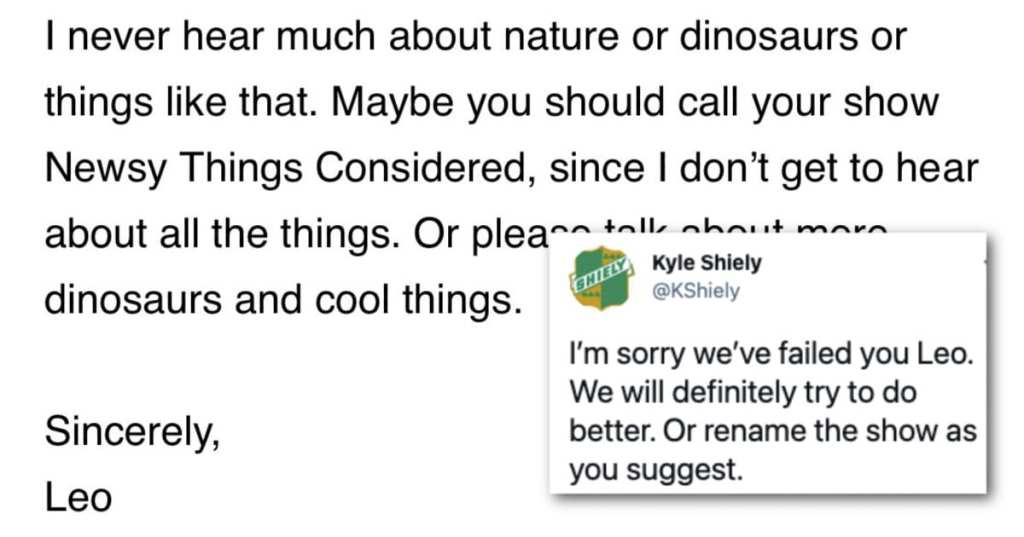Dinosaurs are a topic that fascinates a ton of people, no matter their age. That said, it seems to be a more acceptable obsession the younger you are – like it’s something we’re expected to outgrow as we age, even though new discoveries are happening all the time and we truly love hearing about them.
One little boy doesn’t understand why NPR doesn’t cover more dinosaur news, and he’s taking matters into his own hands.
Leo Shidla is 8 years old, and wrote this letter to his local NPR station in Minneapolis, Minnesota.
I’m sorry we’ve failed you Leo. We will definitely try to do better. Or rename the show as you suggest. pic.twitter.com/cROeJeVQbH
— Kyle Shiely (@KShiely) February 5, 2021
My name is Leo and I am 8 years old. I listen to All Things Considered in the car with mom. I listen a lot.
I never hear much about nature or dinosaurs or things like that. Maybe you should call your show Newsy things Considered, since I don’t get to hear about all the things. Or please talk more about dinosaurs and cool things.
Sincerely,
Leo
When NPR archivists did a search, they found that Leo wasn’t exactly wrong – in 50 years of coverage on All Things Considered, the word dinosaur had appeared only 294 times.
To make amends, the show invited Leo, who wants to be a paleontologist when he grows up, to interview Ashley Poust, a research associate at the San Diego Natural History Museum.
First question!
What’s your favorite part of the job?
“The thing that’s the coolest for me is discovery. There’s nothing better than being out in the field, figuring out where to go and then looking down and finally finding a bit of a dinosaur sticking out of a hill.”
He also likes “getting to work with a lot of really different, really interesting people. But also that exchange of thoughts and ideas like we’re doing right now leads you to come up with really neat ideas about the history of the world and about these amazing animals.”
Have you discovered a dinosaur?
“I have. I would say that I hope to find many more in the future, but I’ve been able to name a few really cool fossil animals. Some of those were discovered by other people in the process of doing fieldwork or even construction. I recently named a dinosaur Wulong, from China. And that was discovered by farmers. I myself have gotten to do some really cool fieldwork in places like Montana and back in China, and I found things ranging from Tyrannosaurus teeth to dinosaur eggs.”
I love Concavenator. How big was it?
Concavenator was a “really interesting animal with huge bones sticking out right up in front of its hips that give it this really sharp sail.”
“It’s a little smaller than, say, your T. rex or your Spinosaurus. A really tall person might have been able to look it in the eye, but if it reared up, it could easily shadow you. And it would be really scary.”
How did dinosaurs grow to be so big and why aren’t humans and mammals the size of dinosaurs today?
“These are the types of questions that keep paleontologists up at night. One thing is that dinosaurs are built different. They have weird bones compared to mammals. Giant long-neck dinosaurs, sauropods, actually have huge holes that are filled with potentially air-like sacs. And so that lightens their bodies and maybe gives them structural strength. They also grow different.
“And so mammals, of course, don’t come from eggs. We have to raise them and we’re famously dependent on our parents. Maybe dinosaurs could lay lots of eggs and leave them and go lay lots of eggs somewhere else.
“They also grew really quickly. And so maybe they’re able to grow to these enormous sizes by being pretty active. And that’s one of my favorite areas of research.
“So they were built different. They grow different, but maybe they’re not that different. Mammals get pretty big. Whales that are alive today are as big as anything the dinosaurs ever produced. And so don’t sleep on whales.”
If you’re totally into this interview and want to hear more stories like it, NPR One made a playlist of stories that Leo – and people who share his interests – are going to love.
Check it out!
Remember to ask for what you want, people – you never know when you just might get it!
